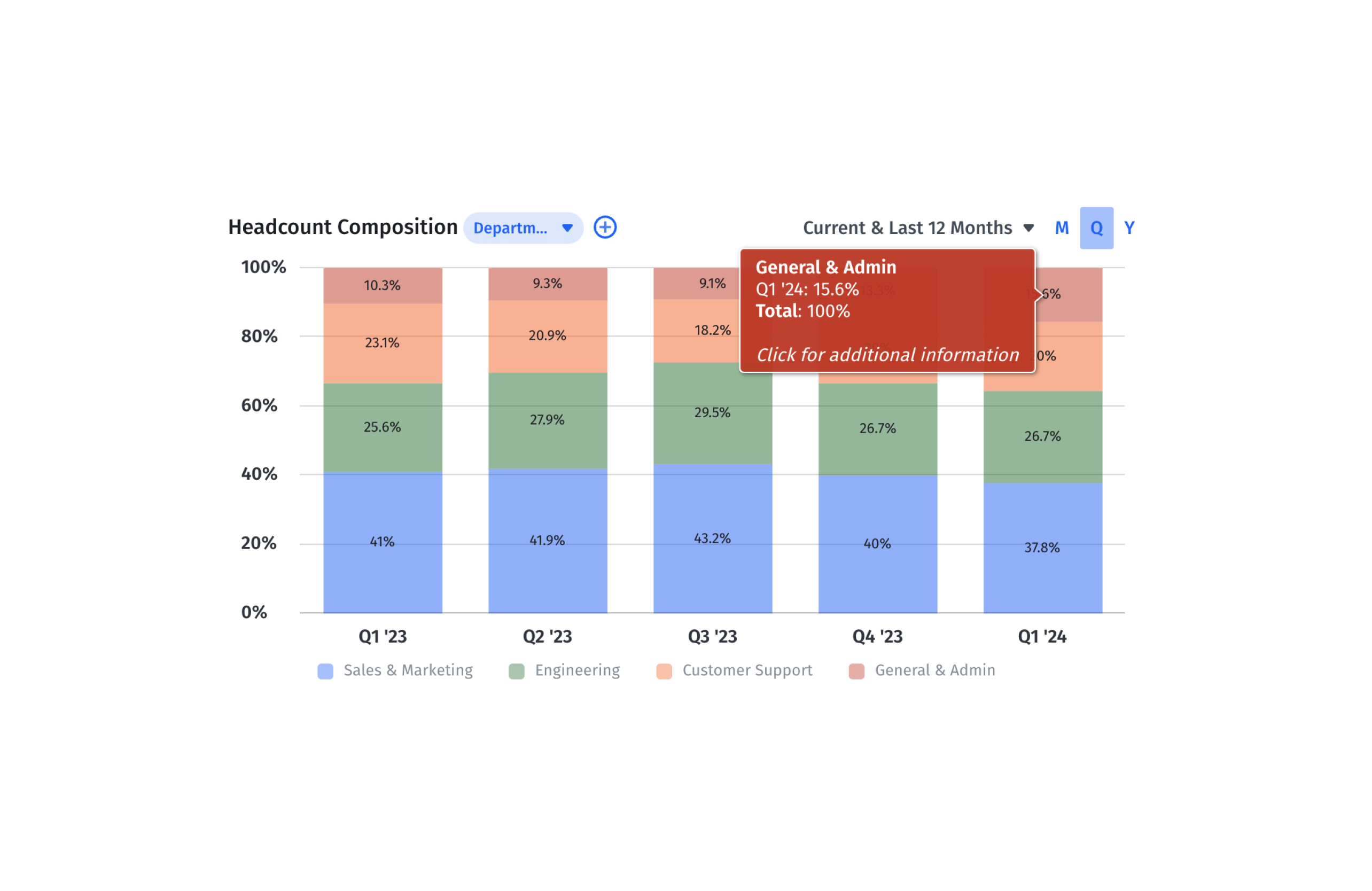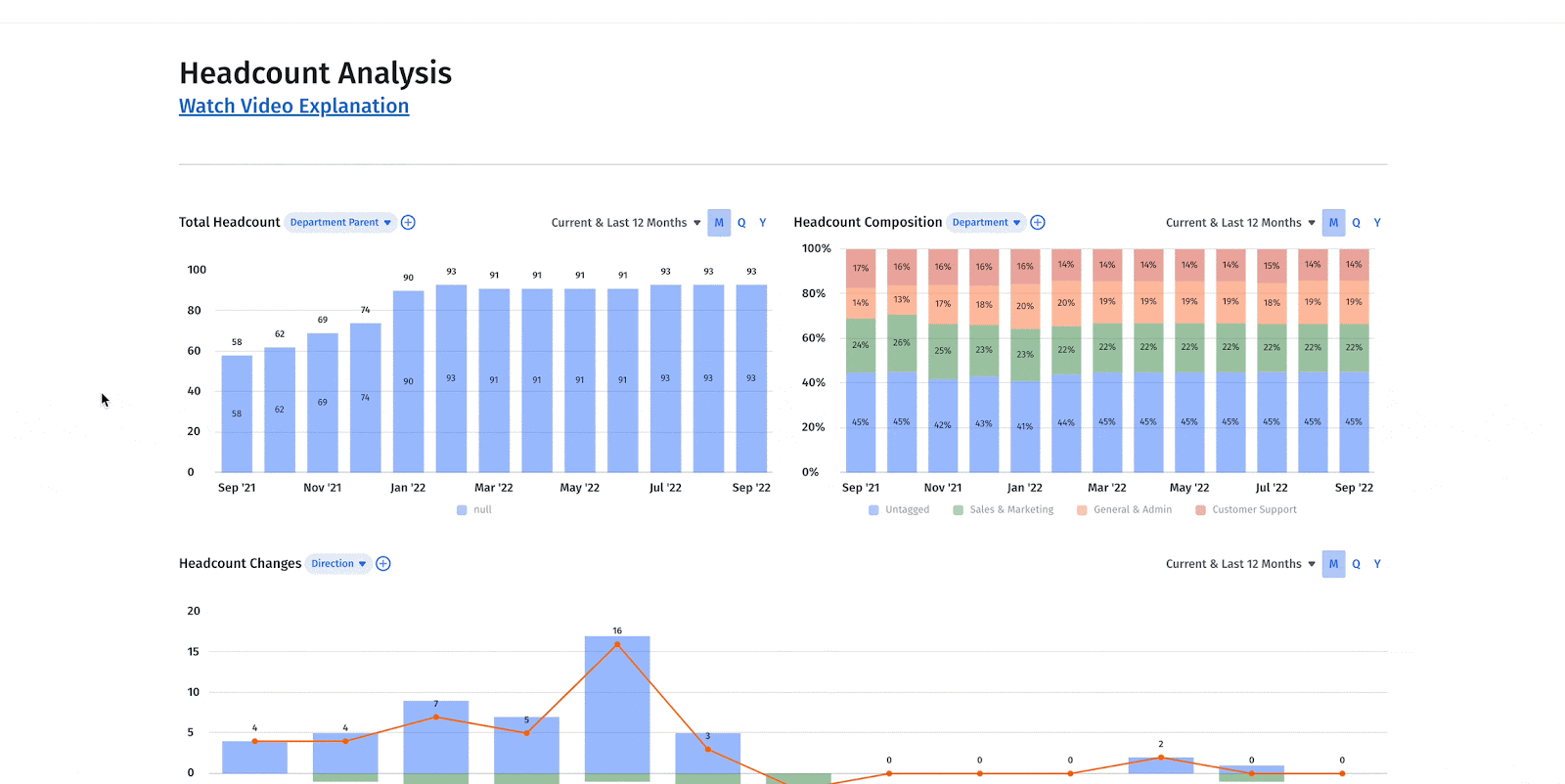HR to Employee Ratio
What is a Human Resource Ratio?
HR to employee ratio is a handy metric in workforce planning and is calculated by dividing the number of human resources (HR) staff by the total number of employees in an organization and then multiplying that by 100. This ratio gives you insight into the number of human resources professionals in the company for every 100 employees.
The HR to employee ratio can influence key business areas such as cost management, resource allocation, scalability, and the strategic involvement of HR in organizational planning.

Categories
Table of Contents
Calculating the HR to Employee Ratio
Growth is the ultimate aim for many businesses — it shapes every strategic move. As your company expands, the role of your HR team becomes increasingly important in navigating the complexities of workforce planning. In such instances, the HR-to-employee ratio is a metric that can offer insights into your total headcount, ensuring you have the right level of support as your business scales.
Essentially, the HR to employee ratio is calculated by dividing the number of HR employees by the total workforce of the company, then multiplying that by 100. This metric indicates your HR team’s operational efficiency and significantly impacts other business areas, including resource allocation and cost management.

To illustrate this, let’s consider a company with 200 employees and five HR team members. In this case, here’s how you’d calculate the HR to employee ratio:
HR to Employee Ratio = 5 (Number of HR Staff) / 200 (Total Number of Employees) X 100 = 0.025 X 100 = 2.5
As you can see, the HR to employee ratio would be 2.5. This means that for every 100 employees, there are approximately two HR professionals. Now, you have a clear picture of the HR team’s workload and how resources are distributed across the company.
A ratio like 2.5 could suggest an average efficiency level, depending on your company size and future business plans. But it’s important not to focus solely on the output of your HR team. Ideally, you should balance maintaining efficiency while ensuring your HR team isn’t stretched too thin. This way, you can think proactively about how the HR team’s present capacity will unfold as the company grows and evolves.
HR to Employee Ratio Calculator
Your HR to Employee Ratio
0
Benchmarks for HR to Employee Ratio
According to the Society for Human Resource Management (SHRM), the average HR to employee ratio stands at 1.70, which translates to nearly 2 HR professionals for every 100 employees.
But here’s the thing – there’s no one-size-fits-all benchmark for this ratio. What makes sense for your company hinges on many things, like how big your company is, where you’re headed in terms of growth, the specific HR needs you have, and the industry you’re in.
Typically, a lower ratio is pretty standard for large organizations with hundreds or thousands of employees. The reasons could be because these companies handle a massive workforce, leverage technology for routine tasks, or bring in outside help, among others. On the flip side, small businesses, especially startups, tend to see higher ratios because of the low headcount — unless they’re in the middle of a high-growth phase.
If your company wants to expand its workforce while maintaining the efficiency of its HR services, a ratio lower than 1.7 could be ideal. Alternatively, if your company is not actively hiring but intends to keep a good employee experience, a ratio between 1.5 and 2.5 could make sense, depending on other factors. In the end, the ideal benchmark for this ratio should be what makes sense for your specific company and its future goals.
Analyzing Your Company’s Ratio
Take, for example, a low HR to employee ratio of 0.6 — this might signal that the HR department is understaffed. In such cases, the HR team could be swamped with administrative tasks, leaving them little room to engage in strategic initiatives. This imbalance can affect the overall effectiveness of the HR function and, by extension, the organization.
That said, a low HR to employee ratio could also indicate an efficient HR team managing many employees with fewer professionals. To dig into the story behind the ratio, you need to look at other headcount metrics and employee turnover metrics in tandem.
Get The 2024 Financial Planning Blueprint

The Impact of HR Ratios on Business Performance
Although it’s often a fly-on-the-wall metric for most SaaS companies, the HR to employee ratio can affect overall business performance.
Simply put, this metric reflects the company’s commitment to its workforce. So, a well-balanced ratio can lead to higher employee satisfaction, better retention rates, and greater operational efficiency — all of which are essential for your company’s overall success.
Here’s how: A favorable HR to employee ratio allows HR staff to engage more closely with employees, understand their needs and concerns, and work on HR processes such as onboarding to improve employee engagement. In other words, your HR team can quickly address issues that might lead to employee turnover, negatively impact employee performance, or cause compliance issues.
On the other hand, an overstretched HR team may find it challenging to engage and support employees meaningfully, potentially leading to higher attrition rates. Monitoring this metric closely can help you effectively align the company’s HR resources with the broader business goals and employee needs.
3 Best Practices in Managing Your HR to Employee Ratio
Once you grasp the HR to employee ratio, you can evaluate how it compares to your internal benchmark and anticipate how the workforce might shift as your company grows. Below, we’ve outlined some best practices to help you manage this metric effectively and make the most of your HR team.
1. Bridge the Gap Between HR and Finance
To succeed in today’s fluid labor market, ensuring all your departments are on the same page and working toward the same goals is more important than ever — starting with finance and HR.
A global survey conducted in 2022 by Workday found that 49% of leaders say the inability to link operational, people, and financial data slows them down. Alarmingly, only 12% say that their data is accessible to the teams and professionals who need it.
Unfortunately, at most companies, many teams still work in their own little bubbles. These silos lead to incomplete data, inconsistent assumptions, and conflicting analyses. In short, this gap can have a costly financial impact.
Ideally, finance and HR teams should work together to oversee the organization’s workforce planning. This way, both departments have the insights needed to handle difficult situations, quickly adapt to changes, make well-informed decisions for the workforce, and support the company’s growth — all of these influence the HR to employee ratio.
Mosaic is a strategic finance platform with a headcount and workforce planning software wrapped into one, with an interface that’s easy for any team. By leveraging a solution like Mosaic, you can bridge the gap between HR and finance, ensuring all teams work based on a real-time, single source of truth.
2. Shift Focus to Strategic HR
We’ve established that your HR to employee ratio can indicate your HR team’s efficiency and gauge their workload. If your HR team is understaffed and overworked due to tedious, routine tasks, it eats into their valuable time that could be better spent on more high-impact, strategic work.
Our tip? Embrace technology to streamline data collection, analysis, and reporting. Just like finance, your HR team should consider using software to automate routine tasks and focus more on strategic workforce planning. Luckily, Mosaic is built for SaaS teams, including human resources, finance, and sales and marketing.
Additionally, solutions like Mosaic ensure your decisions are grounded in reliable data. As stated in Forbes, “Data is your workforce planning friend. By relying on data, you can make informed decisions and justify staffing decisions. Look at current staffing, employee retention rates, employee promotion rates, time-to-hire period and other vital measurements.”
3. Review Metrics Regularly and Plan Accordingly
As the market evolves, so too will your company’s needs. Staying competitive means being agile and ready to adapt swiftly, both in the present and future.
That’s why it’s crucial to regularly review your workforce planning metrics — they not only shape your strategy but also help you quickly catch if you’re veering off the path from your goals.
For example, the labor market in 2022 and 2023 were challenging, especially in the tech sector. In such times, it’s common for companies to exercise caution with their headcount composition and rethink staffing levels.. However, “[…] finding the thin line between managing costs while continuing to fuel growth is highly nuanced, requiring an evolved approach to monitoring and measuring business health,” according to TechCrunch.
In the end, it’s essential to strike a balance between caution and long-term objectives to ensure you’re planning effectively for the future you want for the company. By regularly reviewing your metrics, you’re in a better position to track your progress and quickly adapt to unexpected changes that come your way.
Mosaic’s Role in Workforce Planning and HR Metrics
Mosaic is a strategic finance platform that brings all your key metrics together — including HR to employee ratio. Mosaic integrates seamlessly with your HRIS, ERP, CRM, and billing systems, giving you a complete picture of your workforce.
Before you ask — with over 30 automated data integrations, Mosaic connects with popular HCM systems like Workday, ADP, JustWorks, BambooHR, Gusto, Rippling, and many more.
Mosaic’s Metric Builder is ready to go with preloaded metrics tailored for most SaaS companies, but that’s just the start. It features an easy-to-use dashboard that displays essential headcount metrics, including total headcount, headcount composition, headcount changes, headcount start and end lists, and employee retention percentage.
Plus, you have the flexibility to create custom metrics that are unique to your business. So, really, the insights you can unlock are limitless.
Advanced Analysis with Mosaic

Mosaic automatically pulls employee data from your source systems straight into your financial forecasts, reports, and dashboards. This means less manual work and fewer errors, and better data visibility between HR and finance for headcount planning. You can easily track headcount by department, role, or location and make real-time adjustments while forecasting future hiring needs.
That’s not all. With Mosaic’s intuitive models and data visualization tools, you can build employee forecasts and run “what-if” scenarios with your team leaders on the fly, empowering everyone to make well-informed decisions.
Want to see Mosaic in action? Request a demo.
HR to Employee Ratio FAQs
What is the ideal HR to employee ratio for a company?
The ideal HR to employee ratio often averages around 1.7, but it can vary significantly depending on factors such as your industry, organization size, growth objectives, and other specific variables. Typically, larger companies have a lower HR to employee ratio while smaller organizations have a higher ratio.
Ultimately, the optimal HR to employee ratio benchmark will likely be unique to your business.
What are the risks of having a too high or too low human resource ratio?
How can Mosaic help with headcount planning?
Explore Related Metrics
Own the of your business.




